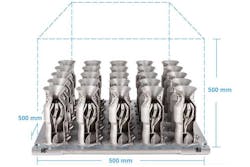Every factory since the start of the industrial revolution has shared one very specific trait: tooling sets the identity of the machines, and thus the factory. To create a specific part requires significant investment to manufacture in volume. Depending on the industry, it takes thousands or hundreds of thousands of parts to make a factory set-up profitable. If factories were computers, they would have to be disassembled and rebuilt each time a new software application was required.
Digitalization is bringing speed and agility to product design and supply chain logistics. New business models are being built around the need for rapid response to consumer demand and rapid design iteration. It all works great until the factory gets involved. Then things slow to a crawl.
Industrial OEMs realize drastic change is required. The global economy is becoming service-oriented. There are new value opportunities to pursue thanks to machine intelligence and increased connectivity. Manufacturers must respond with shorter production cycles that adapt to rapid product ecosystem evolution. They need to move from the traditional model of long lead times and long production cycles using machines that can only work with one identity at a time. The future requires that factories offer identity on demand. Only additive technologies can provide this, and only when they are configured to work alongside traditional manufacturing technologies can change be successful.
For 30 years 3D printing has offered the opportunity to insert digital processes into manufacturing workflows. At first, it was design prototyping, then functional validation. More recently 3D printing provided short-run and bridge manufacturing opportunities. Now the 3D printing industry offers real 3D production manufacturing, thanks to the arrival of the Digital Factory.
Additive technologies offer the ability to create parts from digital CAD, without the need for tooling or fixtures, enabling significant production efficiencies, unconstrained design freedom for improved product performance, and the opportunity for custom manufacturing. With no requirement for tooling, OEMs can perform faster design iterations which means faster time to market.
Earlier this year 3D Systems introduced new scalable additive technologies for the production of plastic parts, known as Digital Molding. Now the company has developed a method of bringing factory-scale production to metal additive, called the DMP Factory 500.
Metal 3D printing is not new. What is new is the ability to deploy metal 3D printing as a modular, scalable solution offering uniform results and repeatable quality. The Digital Factory needs to be scalable, with new inventions to keep a continuous production cycle. This demands new methods to move the powder bed for depowdering and powder recycling, for the automated start of a new build, and then integration with subtractive manufacturing systems for part removal and post-processing.
The modular approach will enable continuous function. Instead of one 3D printing chamber where separate processes must take place sequentially, parts move through function-specific chambers. The initial genius of the Industrial Revolution—machines that repeat the same process over and over—is reborn as specialized chambers for each 3D production process. Direct additive manufacturing at scale requires previously unavailable qualities; these qualities are at the heart of the new Digital Factory.
Digital processes start with software: The Digital factory will demand a new level of integrated software to manage the printing, monitor the builds, and deliver critical process data such as job reports and parameter changes to an ERP system.
Once you have your Metal Digital Factory installed it can print a batch of 500 nozzles of a specific orientation, then immediately start producing 100 brackets in a different orientation. No downtime, no retooling. The continuous production and the ability to match the number and type of modules required for each project minimize manual processes, reducing operational costs.
The Digital Factory clears the way for decreased reliance on tooling. As manufacturers start to realize the time and cost savings, digital production methods will lead to lower spending on the production and storage of tooling and increased use of CAD data. Costs will drop as bottom-line figures improve, driving profitability from within the factory.
Factories that adopt the Digital Factory model will be able to respond quickly to customer needs. Rapid-response metal parts and cast molds can potentially be priced higher. In today’s world of shrinking product lifetimes, it will become unsustainable and intolerable to wait 6-12 weeks for tooling before production can begin. Factories converting to digital 3D methods will be agile, winning work based on both quality and speed. Such Digital Factories will be on the delivery end of disruptive manufacturing processes.
The goal of manufacturing has never been to create great molds and tooling but to create great products for sale. The Digital Factory aligns goals, processes, and systems in a digital workflow—resulting in shorter time to market, increased quality, and lower total cost of operation. The reworking of goals, processes, and systems into a digital workflow offers a new industrial paradigm, an all-digital synergistic workflow for competitive disruption and increased profitability.
Kevin McAlea is Executive Vice President & General Manager, Metals & Healthcare at 3D Systems Corporation—the company that created the 3D printing industry.












